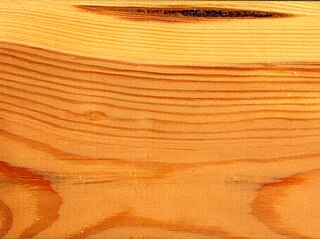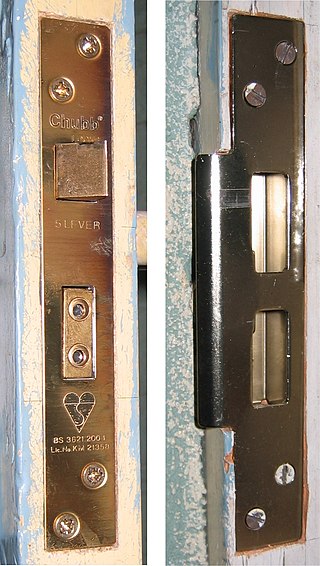
Lumber is wood that has been processed into uniform and useful sizes, including beams and planks or boards. Lumber is mainly used for construction framing, as well as finishing. Lumber has many uses beyond home building. Lumber is referred to as timber in the United Kingdom, Europe, Australia, and New Zealand, while in other parts of the world the term timber refers specifically to unprocessed wood fiber, such as cut logs or standing trees that have yet to be cut.

Joinery is a part of woodworking that involves joining pieces of wood, engineered lumber, or synthetic substitutes, to produce more complex items. Some woodworking joints employ mechanical fasteners, bindings, or adhesives, while others use only wood elements.

Carpentry is a skilled trade and a craft in which the primary work performed is the cutting, shaping and installation of building materials during the construction of buildings, ships, timber bridges, concrete formwork, etc. Carpenters traditionally worked with natural wood and did rougher work such as framing, but today many other materials are also used and sometimes the finer trades of cabinetmaking and furniture building are considered carpentry. In the United States, 98.5% of carpenters are male, and it was the fourth most male-dominated occupation in the country in 1999. In 2006 in the United States, there were about 1.5 million carpentry positions. Carpenters are usually the first tradesmen on a job and the last to leave. Carpenters normally framed post-and-beam buildings until the end of the 19th century; now this old-fashioned carpentry is called timber framing. Carpenters learn this trade by being employed through an apprenticeship training—normally four years—and qualify by successfully completing that country's competence test in places such as the United Kingdom, the United States, Canada, Switzerland, Australia and South Africa. It is also common that the skill can be learned by gaining work experience other than a formal training program, which may be the case in many places.

Softwood is wood from gymnosperm trees such as conifers. The term is opposed to hardwood, which is the wood from angiosperm trees. The main differences between hardwoods and softwoods is that the softwoods completely lack vessels (pores). The main softwood species also have resin canals in their structure.

A hand plane is a tool for shaping wood using muscle power to force the cutting blade over the wood surface. Some rotary power planers are motorized power tools used for the same types of larger tasks, but are unsuitable for fine-scale planing, where a miniature hand plane is used.

A dovetail joint or simply dovetail is a joinery technique most commonly used in woodworking joinery (carpentry), including furniture, cabinets, log buildings, and traditional timber framing. Noted for its resistance to being pulled apart, also known as tensile strength, the dovetail joint is commonly used to join the sides of a drawer to the front. A series of pins cut to extend from the end of one board interlock with a series of 'tails' cut into the end of another board. The pins and tails have a trapezoidal shape. Once glued, a wooden dovetail joint requires no mechanical fasteners.

A mortise lock is a lock that requires a pocket—the mortise—to be cut into the edge of the door or piece of furniture into which the lock is to be fitted. In most parts of the world, mortise locks are found on older buildings constructed before the advent of bored cylindrical locks, but they have recently become more common in commercial and upmarket residential construction in the United States. The design is widely used in domestic properties of all vintages in Europe.

A butt joint is a wood joint in which the end of a piece of material is simply placed against another piece. The butt joint is the simplest joint. An unreinforced butt joint is also the weakest joint, as it provides a limited surface area for gluing and lacks any mechanical interlocking to resist external forces.

André Jacob Roubo (1739–1791) was a French carpenter, cabinetmaker and author. Roubo was born and died in Paris, and was the son and grandson of master cabinetmakers. Roubo wrote several highly influential books on woodworking, an achievement which was especially notable given his relatively poor background and self-taught methods.
International Woodworkers of America (IWA) was an industrial union of lumbermen, sawmill workers, timber transportation workers and others formed in 1937.

Coping or scribing is the woodworking technique of shaping the end of a moulding or frame component to neatly fit the contours of an abutting member. Joining tubular members in metalworking is also referred to as a cope, or sometimes a "fish mouth joint" or saddle joint.
This glossary of woodworking lists a number of specialized terms and concepts used in woodworking, carpentry, and related disciplines.
Central Aircraft Company Limited was a British aircraft manufacturer from its formation in 1916 to its closure in 1926.

Fine Woodworking is a woodworking magazine published by Taunton Press in Newtown, Connecticut, USA.
Magnet is a British kitchen retailer operating in over two hundred locations across the United Kingdom supplying products under the Magnet and Magnet Trade brands. The company has over 2,000 employees and its headquarters are in Darlington, County Durham.

Tom M. Scotney Ltd was a British timber and joinery and timber construction business in St. Ives, Huntingdonshire. Scotney's was greatly enlarged by wartime defence contracts which included prefabricated buildings for searchlight installations and buildings for other special purposes in other counties and hundreds of special wooden boats for the D-day landing in France. In the late 1940s Scotney, obliged to diversify, added heavy truck trailers and related activities including timber-framed coachbuilding for local motor dealers during the post-war steel shortages. After two takeovers Scotney's closed its doors in mid-1970.

Alfredson's Joinery is a heritage-listed workshop at 28 King Street, Cooran, Shire of Noosa, Queensland, Australia. It was built from 1930s to 1950s. It is also known as Alfredson's Pre-Cut House Workshop and Alfredson's Sawmill. It was added to the Queensland Heritage Register on 27 November 2008.

Hastings is a heritage-listed former residence and now multiple residences at 2 Hayes Street, Neutral Bay, North Sydney Council, New South Wales, Australia. The 1913 house was reputedly designed by Edward Jeaffreson Jackson and built from 1830 to 1913. It is also known as Thrupp's Cottage; Craignathan; The Hastings; Milton. The property is privately owned. It was added to the New South Wales State Heritage Register on 2 April 1999.
cadwork informatik CI AG is a multinational software company headquartered in Basel, Switzerland. It develops and markets software products primarily for the construction industry. These products include timber industry products in computer-aided design (CAD) and computer-aided manufacturing (CAM) as well as products in building information model (BIM) and virtual design and construction (VDC). These products are suitable for designers, structural engineers, construction engineers, civil engineering draftspeople, building contractors, and in the case of BIMTeam VDC, the construction crews.














